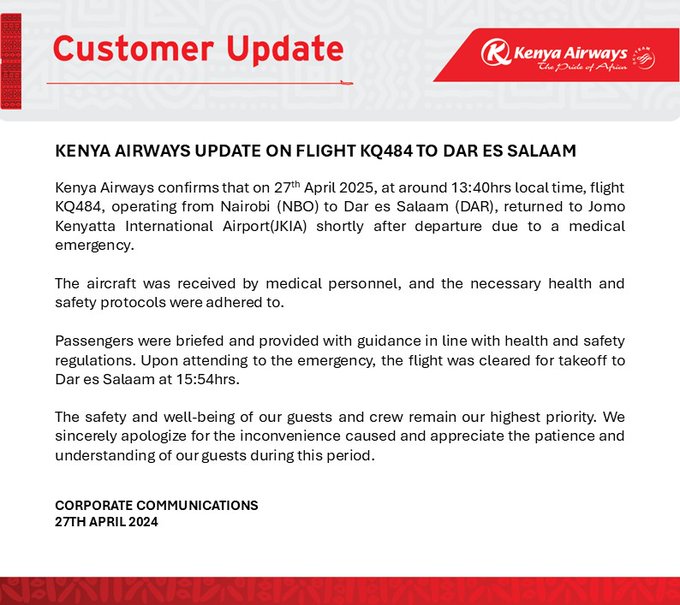On April 27, 2025, a Kenya Airways (KQ) flight, KQ484, bound for Dar es Salaam from Nairobi’s Jomo Kenyatta International Airport (JKIA) made headlines after returning to base shortly after takeoff. Initial reports, fueled by passenger accounts and media speculation, suggested a hazardous biological material leak—possibly Tuberculosis bacilli—in the cargo hold. However, Kenya Airways has since issued an official customer update, confirming that the incident was due to a medical emergency, not a bio-chemical leak. Magari Poa brings you the latest on this developing story, dispelling rumors and highlighting KQ’s response.
Official Statement from Kenya Airways
In a statement released on April 27, 2025, at 5:03 PM EAT via their official X account, Kenya Airways clarified the circumstances surrounding flight KQ484. The flight, which departed JKIA at approximately 1:34 PM, returned to Nairobi at 1:40 PM due to a medical emergency. “Kenya Airways confirms that on 27th April 2025, at around 13:40hrs local time, flight KQ484, operating from Nairobi (NBO) to Dar es Salaam (DAR), returned to Jomo Kenyatta International Airport (JKIA) shortly after departure due to a medical emergency,” the airline stated.
The aircraft was met by medical personnel upon landing, and all necessary health and safety protocols were followed. After the situation was resolved, the flight was cleared for takeoff to Dar es Salaam at 1:54 PM. Kenya Airways did not disclose specific details about the nature of the medical emergency, likely to protect passenger privacy, but the swift resolution suggests effective coordination with ground medical teams.
Debunking the Bio-Chemical Leak Rumor
Early reports from outlets like Nation Africa and Eastleigh Voice, amplified by posts on X, claimed the flight returned due to a suspected leak of hazardous biological material, specifically Tuberculosis bacilli. These claims, attributed to passenger sources, sparked widespread concern about airline safety and cargo handling at JKIA. Posts on X, including from
@NationAfrica
and
@Mike_Kutola
, fueled speculation about a potential public health risk.
However, Kenya Airways’ official communication directly contradicts these reports, confirming that no bio-chemical incident occurred. The airline’s transparency in addressing the situation helps quell fears and underscores the importance of relying on verified information. The initial misinformation may have stemmed from passenger confusion or miscommunication during the in-flight announcement, a common issue in high-stress situations.
Context and Public Reaction
The KQ484 incident occurred on a routine 1-hour-25-minute flight covering 415 miles between Nairobi and Dar es Salaam, a key route for Kenya Airways, which operates daily services between the two cities. The flight, tracked by platforms like FlightAware and AirNav Radar, typically departs from JKIA’s Terminal 1A and arrives at Dar es Salaam’s Julius Nyerere International Airport Terminal 3.
Public sentiment on X reflects relief at KQ’s clarification but also lingering concerns about airline operations.
@Eastleighvoice
echoed KQ’s statement, noting the medical personnel’s response, while other users called for improved communication to prevent rumors. The incident’s timing is sensitive, as JKIA faces scrutiny over a controversial Adani Group management deal, and KQ continues to recover from past challenges like a 2023 ransomware attack.
Kenya Airways’ Safety Protocols
Kenya Airways’ handling of the KQ484 incident aligns with its established protocols for medical emergencies, as outlined on their website. The airline provides services for passengers requiring special medical assistance and maintains robust coordination with ground teams. The quick turnaround—resolving the emergency and resuming the flight within 20 minutes—demonstrates operational efficiency and adherence to International Civil Aviation Organization (ICAO) safety standards.
However, the incident highlights the need for clear in-flight communication to prevent passenger panic and misinformation. KQ’s cargo operations, recently praised with the Highly Acclaimed African Air Cargo Airline of the Year award in February 2025, may also face renewed scrutiny to ensure hazardous materials are not mistakenly linked to routine incidents.
What This Means for Travelers
For passengers planning to fly with Kenya Airways, this incident underscores the airline’s commitment to safety but also the importance of staying informed. Here are Magari Poa’s recommendations:
-
Verify Information: Rely on official statements from KQ or trusted sources like MagariPoa.com to avoid misinformation.
-
Know Emergency Procedures: Familiarize yourself with KQ’s medical assistance policies, available on their website, especially if you have health concerns.
-
Stay Calm: In-flight incidents are often resolved quickly, as seen with KQ484’s 20-minute turnaround.
-
Flexible Booking: Choose KQ’s flexible ticket options (fares start at USD 289 round-trip for NBO-DAR) to accommodate potential disruptions.
Looking Ahead
Kenya Airways’ prompt response to the KQ484 medical emergency and its clarification of the bio-chemical leak rumor reflect a commitment to passenger safety and transparency. However, the incident highlights the challenges of managing public perception in the age of rapid social media updates. Magari Poa urges KQ to enhance in-flight communication and continue strengthening cargo screening to maintain trust.
As the investigation into the medical emergency concludes, we commend the crew and medical teams for their swift action. For the latest travel updates, safety tips, and exclusive insights, visit MagariPoa.com. Let’s keep flying safely with the Pride of Africa.

Sources: Kenya Airways official statement, K24 Digital, Eastleigh Voice, posts on X, FlightAware, Kenya Airways website
Discover more from Magari Poa
Subscribe to get the latest posts sent to your email.

